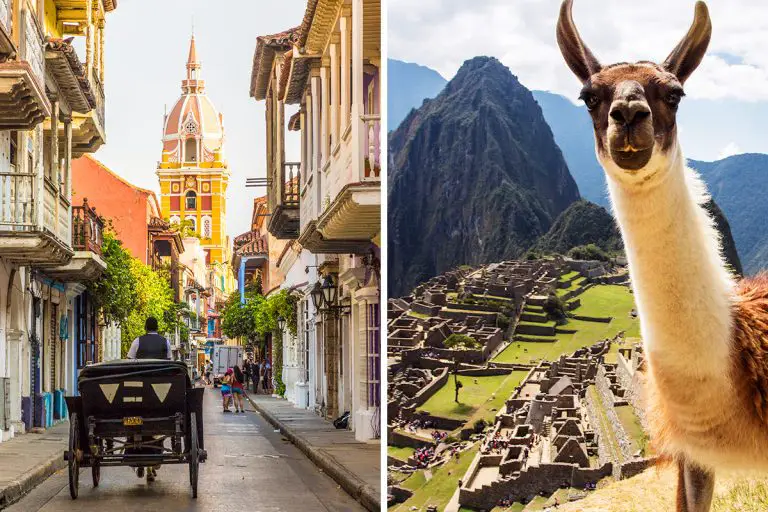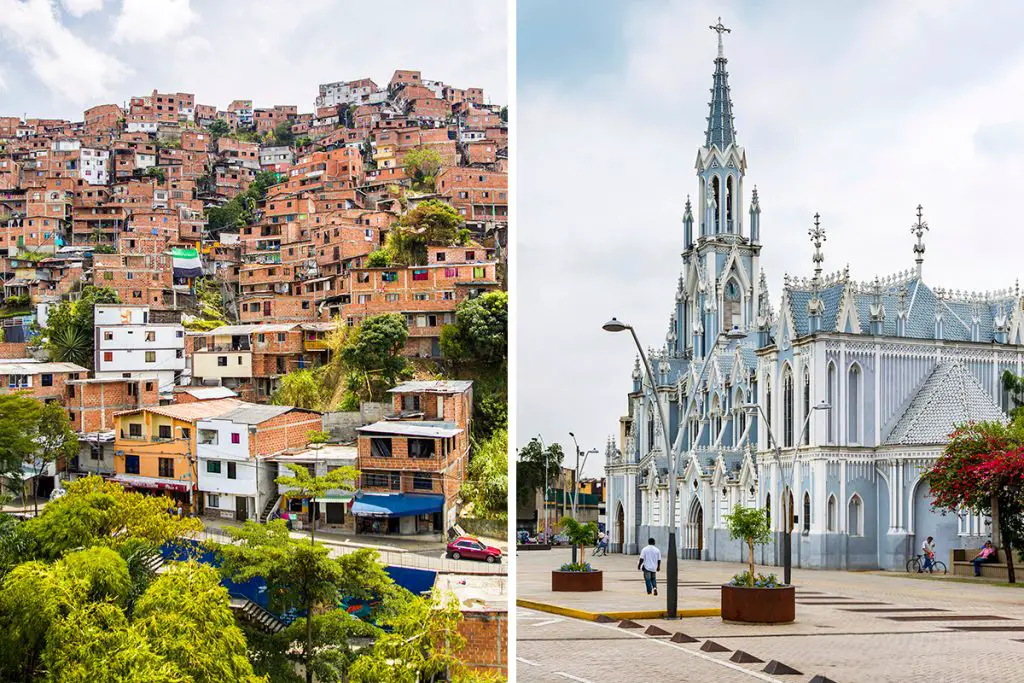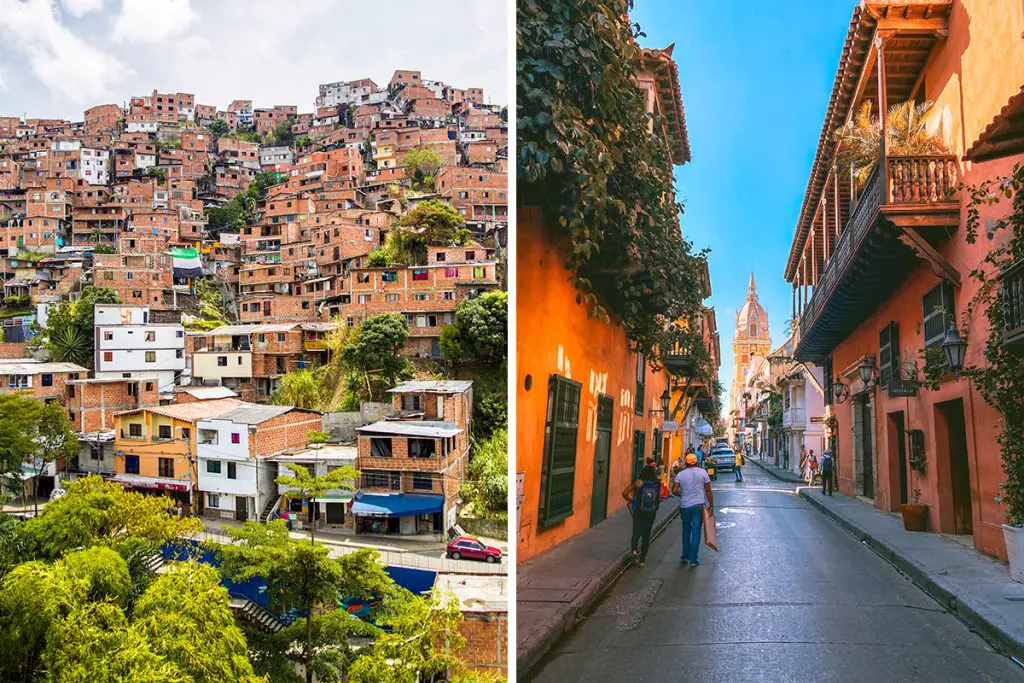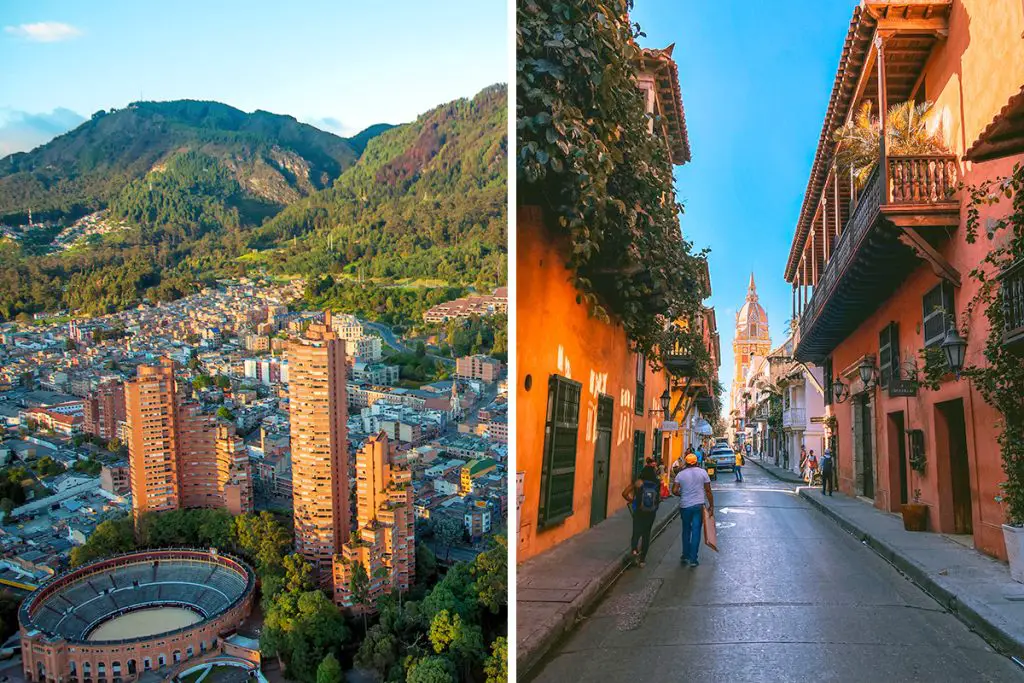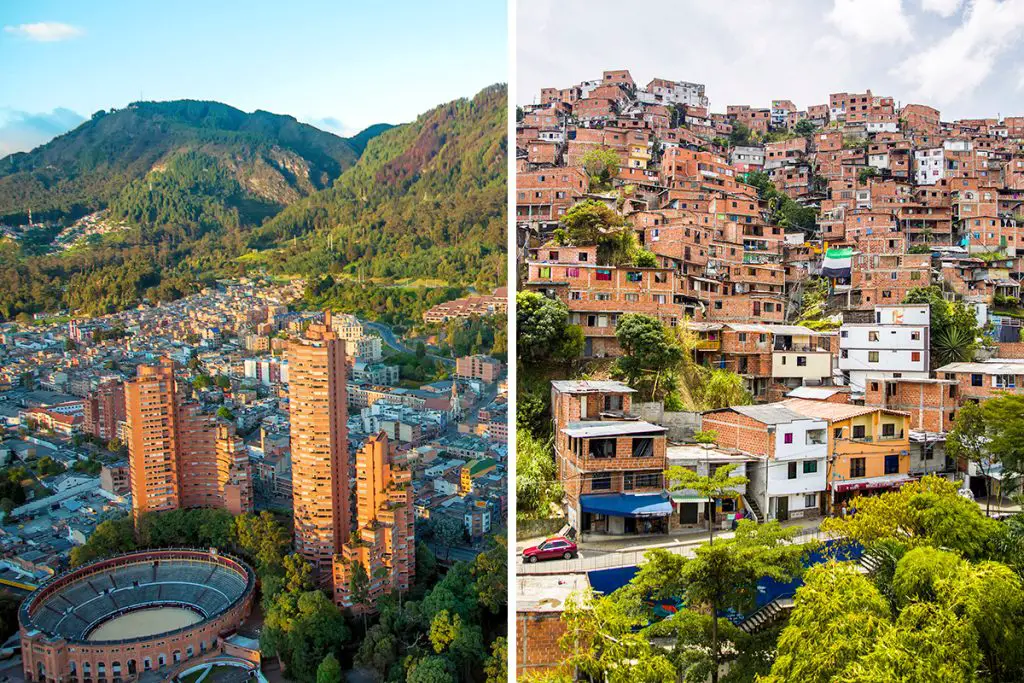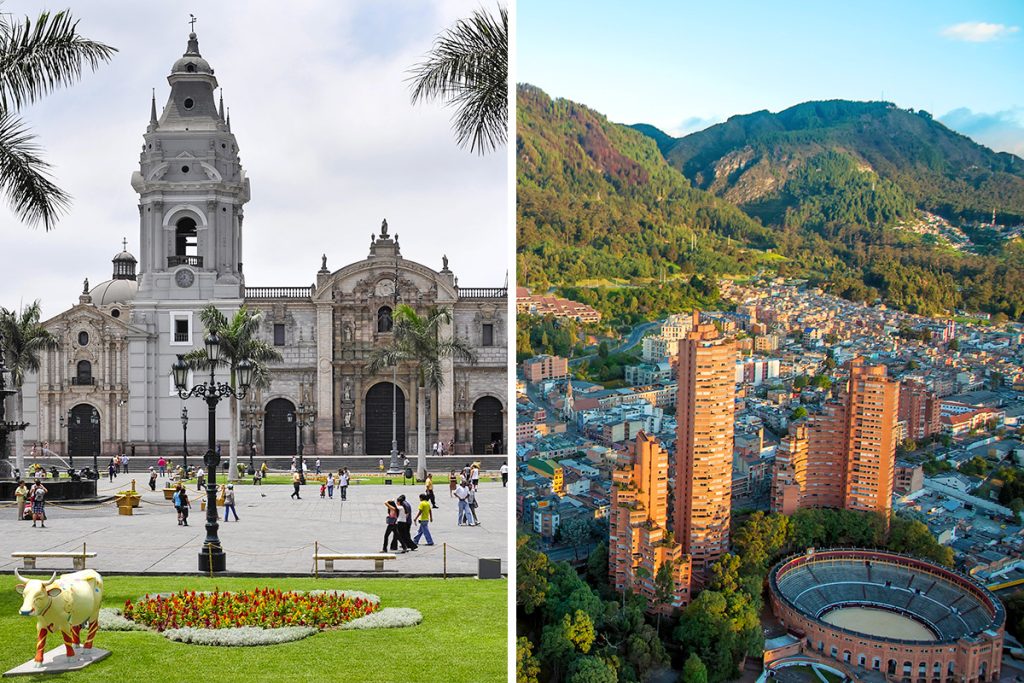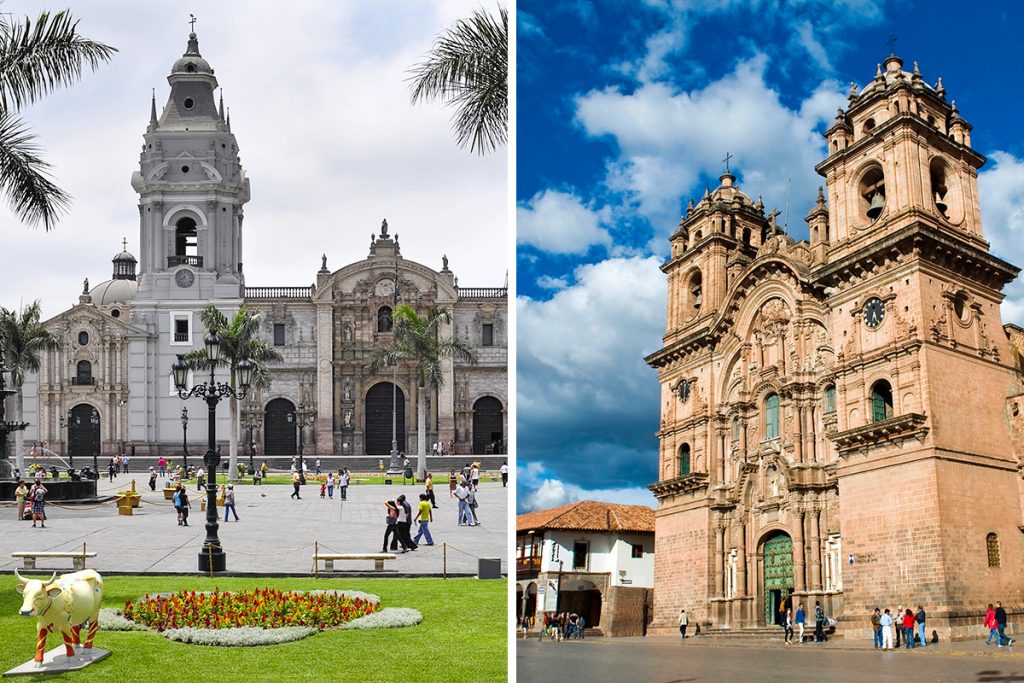While planning your trip, it’s essential to weigh the unique aspects of each destination to ensure the best experience possible. This comparison will guide you through the various factors to consider, such as attractions, activities, and costs. So, read on to discover which country – Colombia or Peru – will be the ideal choice for your next adventure!
History & Culture
Delving into the history and culture of Colombia and Peru can be fascinating. Both countries boast a rich past that shapes their present.
In Colombia, ancient civilizations like the Tairona and Muisca once thrived. The Spanish conquest in the 16th century greatly influenced the country’s culture, blending indigenous traditions with European ones. Today, Colombia celebrates its diverse heritage through colorful festivals, music, and dance.
On the other hand, Peru is famous for its Inca civilization, which left an indelible mark on the country’s culture. Before the Inca Empire, numerous other cultures, such as the Moche and Nazca, flourished. Like Colombia, Peru experienced Spanish colonization, which also melded local and European customs.
Both countries share similarities in their historical journey, yet each has developed its unique cultural identity. Colombian culture is a lively mix of indigenous, African, and European influences, reflected in its art, literature, and music, such as cumbia and salsa.
Peruvian culture, too, is a blend of indigenous, European, African, and Asian influences. The country is known for its traditional music, dances like the Marinera, and world-renowned literature from authors like Mario Vargas Llosa.
In summary, the history and culture of Colombia and Peru are equally rich and diverse. Both countries have unique traditions shaped by their past, making them captivating destinations for history and culture enthusiasts.
Attractions & Activities
Exploring the attractions and activities in Colombia and Peru is an unforgettable experience. Both countries offer a wide range of options to suit various interests.
Colombia’s attractions include the historic city of Cartagena, with its well-preserved colonial architecture, and the vibrant capital city, Bogotá, home to many museums and art galleries. For nature lovers, the Cocora Valley and Tayrona National Park offer breathtaking landscapes and diverse wildlife.
Peru’s most famous attraction is undoubtedly Machu Picchu, the ancient Inca citadel nestled high in the Andes. Besides Machu Picchu, Peru has other archaeological sites like the Sacred Valley and the Nazca Lines. Nature enthusiasts can explore the Amazon Rainforest, Lake Titicaca, or the Colca Canyon for stunning scenery and wildlife encounters.
Adventure seekers will find plenty to do in both countries. In Colombia, hiking in the Andes, paragliding in San Gil, or exploring the underground Salt Cathedral of Zipaquirá are popular activities. Peru offers trekking along the Inca Trail, sandboarding in Huacachina, and exploring the Ballestas Islands.
In both Colombia and Peru, you can engage in immersive cultural experiences. Learn about traditional coffee production in Colombia’s Coffee Triangle or participate in a weaving workshop in the Peruvian Andes.
To sum up, Colombia and Peru offer a wealth of attractions and activities for travelers to enjoy. Whether you’re interested in history, nature, or adventure, you’re sure to find something captivating in both destinations.
Beaches
When it comes to beautiful beaches, both Colombia and Peru have their fair share. Each country offers unique coastal experiences for beach lovers.
Colombia boasts over 1,760 miles (2,832 kilometers) of coastline along the Caribbean Sea and Pacific Ocean. Some of the most popular beaches are found in Tayrona National Park, where you’ll discover pristine sands, turquoise waters, and lush jungle backdrops. The Rosario Islands, near Cartagena, is also a favorite for its idyllic scenery and crystal-clear waters.
Peru, on the other hand, has approximately 1,500 miles (2,414 kilometers) of coastline. While not as famous for beaches as Colombia, it still has some hidden gems. Máncora, in northern Peru, is a popular beach destination known for its sandy shores, warm waters, and consistent surf breaks. Punta Sal, close to Máncora, offers a more relaxed atmosphere with fewer crowds.
Both countries have beaches suitable for various activities. Colombia’s San Andrés and Providencia islands are perfect for snorkeling and scuba diving, while Peru’s beaches cater more to surfers, with spots like Chicama and Punta Rocas.
In terms of accessibility, Colombia’s beaches are generally easier to reach, with many located near major cities like Cartagena and Santa Marta. Peru’s top beaches are often more remote and may require longer travel times.
In summary, both Colombia and Peru offer beautiful beaches for different preferences. Colombia has a wider variety of beach experiences, while Peru caters more to surfers and those seeking less crowded spots.
Eating, Drinking & Nightlife
When it comes to eating, drinking, and nightlife, Colombia and Peru each have unique offerings that cater to various tastes.
Colombian cuisine is a delightful mix of flavors, influenced by indigenous, Spanish, and African culinary traditions. Popular dishes include bandeja paisa, arepas, and ajiaco. As for drinks, Colombia is famous for its coffee, but you should also try aguardiente, a local spirit.
Peruvian cuisine is considered one of the best in the world, with dishes like ceviche, lomo saltado, and causa rellena. Peruvian beverages include the famous pisco sour, made from pisco, a grape brandy, and chicha morada, a refreshing non-alcoholic drink made from purple corn.
Nightlife in Colombia is vibrant and diverse. Major cities like Bogotá, Medellín, and Cartagena have lively scenes, with bars, clubs, and salsa dancing venues. Cali, known as the “Salsa Capital of the World,” is a must-visit for dance enthusiasts.
Peru’s nightlife scene may be more subdued compared to Colombia, but it still offers a range of options. Lima, the capital city, has a thriving bar and club scene, especially in neighborhoods like Miraflores and Barranco. Cusco, the gateway to Machu Picchu, also has a lively nightlife, with many bars and clubs catering to international travelers.
In conclusion, both Colombia and Peru have much to offer when it comes to eating, drinking, and nightlife. Colombia might be better for those seeking a more energetic atmosphere, while Peru is ideal for food enthusiasts and those preferring a more relaxed nightlife experience.
Shopping
Shopping can be an exciting part of any vacation. Both Colombia and Peru offer unique shopping experiences, with different products and markets to explore.
In Colombia, you’ll find a variety of malls, markets, and boutiques, especially in cities like Bogotá, Medellín, and Cartagena. Colombian crafts, such as mochilas (hand-woven bags) and handmade pottery, make excellent souvenirs. Don’t forget to try Colombian coffee and bring some back home.
Peru also has a rich shopping scene, with colorful markets and traditional crafts. Lima, Cusco, and Arequipa have many shops and markets where you can buy Peruvian textiles, alpaca products, and silver jewelry. Make sure to visit Pisac Market, a famous artisan market in the Sacred Valley.
Both countries have vibrant local markets. In Colombia, check out Paloquemao Market in Bogotá for fresh produce and traditional snacks. In Peru, visit San Pedro Market in Cusco to sample local delicacies and shop for unique items.
Colombia has more upscale shopping options, with many malls and designer stores in cities like Bogotá and Medellín. Peru’s shopping scene is more focused on traditional crafts and local products.
In terms of prices, both Colombia and Peru can be affordable, but it depends on what you’re shopping for. High-quality crafts and designer items might be more expensive, while local markets often have lower prices.
In conclusion, shopping in Colombia and Peru can be a delightful experience, with each country offering unique products and markets. Colombia might be better for those seeking more upscale shopping, while Peru is ideal for those interested in traditional crafts and local items.
Accommodation
Finding a comfortable place to stay is important when traveling. Colombia and Peru both offer a range of accommodation options to suit different budgets and preferences.
Colombia has a variety of hotels, hostels, and guesthouses. Cities like Bogotá, Cartagena, and Medellín have many choices, from luxury hotels to budget-friendly hostels. Boutique hotels in historic buildings are popular in Cartagena’s Old Town.
Peru also has numerous accommodation options, from five-star hotels in Lima to cozy hostels in Cusco. Unique stays, such as staying in a traditional guesthouse in the Sacred Valley, can add to your Peruvian experience.
Both countries have options for travelers seeking eco-friendly or sustainable accommodations. Colombia has eco-lodges in natural settings like the Amazon, while Peru offers eco-friendly hotels near attractions like Machu Picchu.
In general, accommodation prices in Colombia and Peru can be similar, but it depends on the location and type of lodging. Major cities and tourist destinations tend to have higher prices, while rural areas and smaller towns may offer more affordable options.
In summary, both Colombia and Peru provide a range of accommodation choices to suit various budgets and tastes. The best option for you will depend on your preferences, travel goals, and budget.
Family-Friendliness & Children’s Activities
Traveling with your family can be a memorable experience. Both Colombia and Peru have family-friendly attractions and activities that can make your trip enjoyable for everyone.
In Colombia, you can explore the interactive museums in Bogotá, such as the Gold Museum and the Children’s Museum. Cartagena offers kid-friendly activities like visiting the Rosario Islands for a day of snorkeling and beach time. Medellín’s Explora Park is another exciting option, with its interactive science exhibits and aquarium.
Peru is also great for families. Lima has many parks and museums that are engaging for children, like the Magic Water Circuit and the Larco Museum. Cusco, the gateway to Machu Picchu, has activities like chocolate-making workshops that kids will love. The Ballestas Islands, near Paracas, offer a chance to see wildlife like sea lions and penguins up close.
Both countries have outdoor activities that can be fun for the whole family. In Colombia, you can visit the Cocora Valley for gentle hikes among tall wax palm trees. In Peru, the Sacred Valley has easy treks and outdoor adventures suitable for all ages.
It’s important to note that some attractions in both countries might be more challenging for younger children, such as high-altitude locations in Peru or long hikes in Colombia. Careful planning and adjusting to local conditions can help ensure a successful family trip.
In summary, Colombia and Peru both offer a range of family-friendly activities and attractions. Your choice will depend on your family’s interests and the type of experiences you’re seeking.
Getting There & Getting Around
Accessibility is an important factor when planning a trip. Both Colombia and Peru have good transport options to get you there and help you explore once you’ve arrived.
To reach Colombia, international flights land in major cities like Bogotá, Medellín, and Cartagena. From the US, flight times vary from 3 to 7 hours, depending on the departure city. In Peru, most international flights arrive in Lima, with flight times from the US ranging from 5 to 10 hours.
Once in Colombia, domestic flights connect the main cities, and buses are a budget-friendly option for longer distances. In larger cities, taxis and rideshare services like Uber are available for getting around. In smaller towns, you might find moto-taxis or shared vans called colectivos.
In Peru, domestic flights and long-distance buses connect major cities and tourist destinations. For shorter distances, taxis and colectivos are common. Lima also has a public transportation system, the Metropolitano, which is a rapid bus transit system.
Both countries have a variety of transport options for exploring popular tourist areas. In Colombia, for example, you can take a boat to the Rosario Islands from Cartagena. In Peru, you can reach Machu Picchu by train or on foot via the Inca Trail.
In conclusion, getting to and around Colombia and Peru is generally straightforward, with a range of transportation options available. Your choice will depend on your travel preferences, budget, and the destinations you plan to visit.
Weather
When planning a trip, the weather can be a crucial factor. Comparing the climates of Colombia and Peru will help you decide the best time to visit each destination.
Colombia’s location near the equator results in a consistent climate throughout the year. Coastal cities like Cartagena experience hot and humid conditions, with temperatures around 86°F (30°C). Bogotá, at a higher altitude, has milder temperatures averaging 66°F (19°C). The rainy season in Colombia generally occurs from April to May and from October to November.
Peru’s weather varies significantly depending on the region. Coastal cities like Lima experience mild temperatures year-round, averaging 66°F (19°C), with the warmest months being January and February.
The Andean highlands, including Cusco and the Sacred Valley, have a rainy season from November to March and a dry season from April to October. During the dry season, daytime temperatures can reach 68°F (20°C), while nights can be chilly.
Both countries offer diverse weather conditions. Colombia’s consistent climate allows for year-round travel, while Peru’s weather varies by region and season. Careful planning can help you make the most of your visit to each country.
Safety
Safety is an important consideration when traveling. By comparing safety in Colombia and Peru, you can make informed decisions about your trip.
In general, Colombia has made significant progress in recent years in terms of safety. Most tourist areas are considered safe, but you should still be cautious of petty crime like pickpocketing and bag-snatching. Avoid traveling to remote regions, and be cautious in crowded areas or on public transportation.
Peru is also considered relatively safe for tourists. Petty crime, such as pickpocketing, is a concern in crowded areas and on public transportation. As in Colombia, you should be cautious with your belongings and avoid displaying expensive items.
In both Colombia and Peru, it’s essential to be aware of local conditions and take necessary precautions. For example, if you plan to visit high-altitude areas in Peru, be prepared for altitude sickness and acclimatize properly before engaging in strenuous activities.
In summary, both Colombia and Peru have safety concerns typical of many tourist destinations. With proper precautions and an awareness of your surroundings, you can have a safe and enjoyable trip in either country.
Cost
Travel expenses can greatly influence your choice between Colombia and Peru. Comparing costs in both countries will help you budget your trip more effectively.
In Colombia, the cost of living is relatively affordable. A typical meal at a local restaurant may cost around 15,000 Colombian pesos ($4). Accommodation options vary, with budget hostels starting at 30,000 pesos ($8) per night, and mid-range hotels from 100,000 pesos ($27).
Peru also offers affordable travel experiences. You can expect to pay around 20 Peruvian soles ($5) for a meal at a local restaurant. Hostels in Peru start at 30 soles ($8) per night, while mid-range hotels can be found at 150 soles ($40).
When it comes to transportation, both Colombia and Peru have budget-friendly options. In Colombia, a short taxi ride may cost around 5,000 pesos ($1.35), and a long-distance bus trip could be 50,000 pesos ($13.50). In Peru, a taxi ride may be around 10 soles ($2.70), and long-distance buses start at 60 soles ($16).
In summary, both Colombia and Peru are budget-friendly destinations, with Colombia being slightly more affordable overall. The cost difference is not significant, and both countries offer excellent value for travelers seeking diverse experiences at reasonable prices.
Which Is Better – Colombia or Peru?
After comparing the history, culture, attractions, activities, beaches, eating, drinking, nightlife, shopping, accommodation, family-friendliness, children’s activities, transportation, weather, safety, and costs, you might wonder which destination is better: Colombia or Peru?
Colombia may be the ideal choice if you prefer consistent weather, diverse landscapes, and vibrant cities. Its rich history, charming colonial architecture, and bustling urban centers offer a unique blend of experiences. Additionally, Colombia’s affordability makes it an attractive option for budget-conscious travelers.
On the other hand, Peru is perfect for those interested in ancient civilizations, stunning natural wonders, and diverse cultural experiences. With famous sites like Machu Picchu, the Amazon Rainforest, and Lake Titicaca, Peru offers countless opportunities for adventure and exploration. The country’s rich culinary scene and lively nightlife also make it a favorite among food enthusiasts and party-goers.
In conclusion, both Colombia and Peru have much to offer, and your choice will depend on your personal interests and preferences. By carefully considering the factors outlined in this article, you can make an informed decision and plan an unforgettable trip to either destination.

